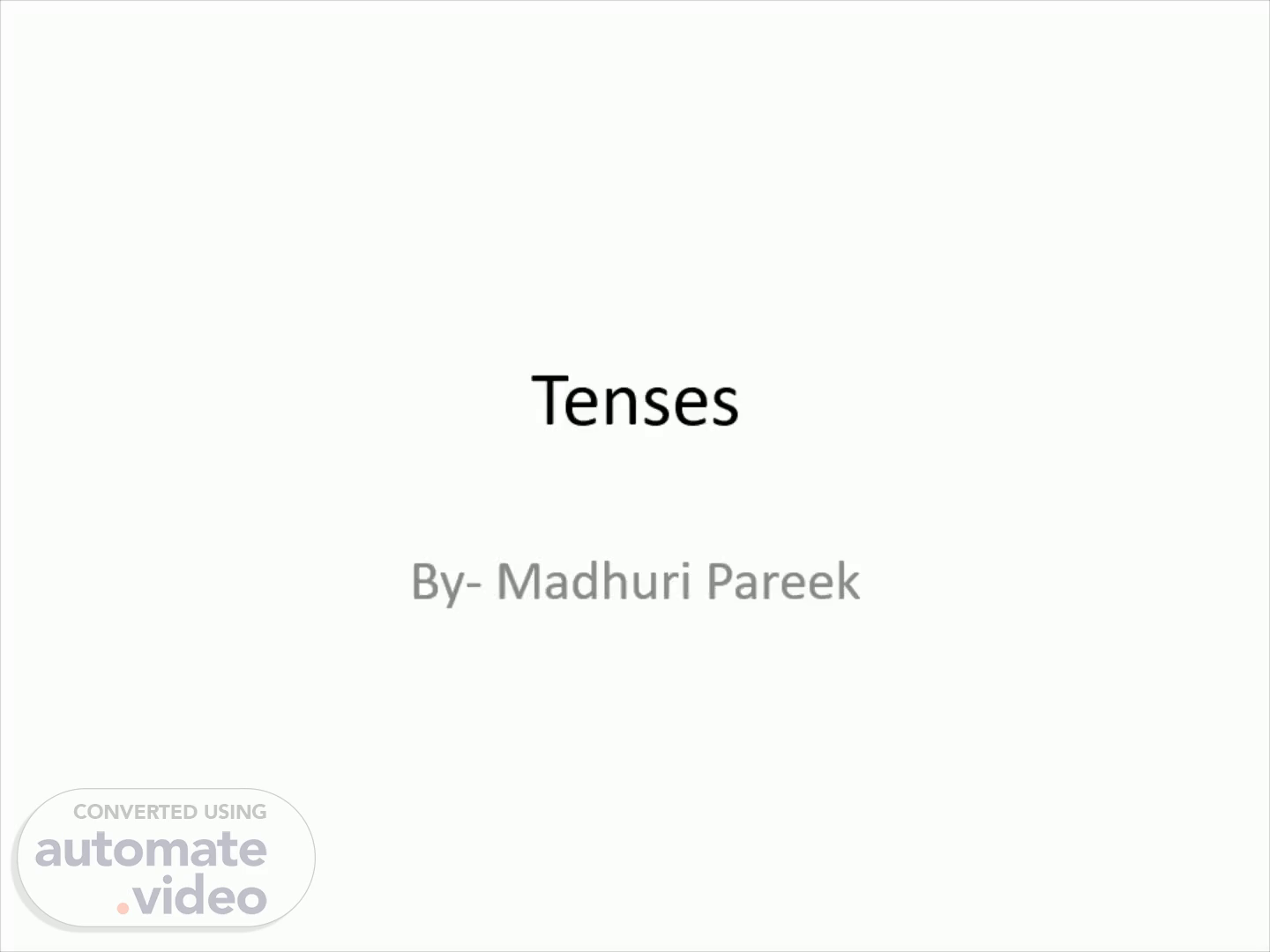Scene 1 (0s)
Tenses. By- Madhuri Pareek.
Scene 2 (6s)
What is Tenses?. A tense verb form describes any action, circumstance, event, or state of being in any sentence structure..
Scene 3 (16s)
Types of tenses. Present tense Past tense Future tense..
Scene 4 (24s)
Present tense. Present tense. A present tense describes any action that is commonly performed or is happening in a current situation. types of present tenses Simple present tense speaks about the present actions, events, or conditions which are occurring in the current situation . Structural formula: Subject + verb (s/ es ) + object. Here, the verb is in its base form . Example He plays the piano. Romie loves to eat burgers. We produce biogas from manure. I go to the gym daily..
Scene 5 (47s)
Present Continuous (progressive) Tense. Present Continuous (progressive) Tense.
Scene 6 (1m 15s)
Present Perfect Tense. Present Perfect Tense. The present perfect tense is used to express the situation or event which is completed but in a present consequence. It is a combination of the ideal aspect done in the present tense. Structural formula: Subject + helping verb (have/has) + verb ( ed ) + object. Here, the modal verb “has” is being used for the second person (He, She, It, etc.), and “have” is used for the first-person and third-person (I, you, they, we, etc.) respectively. Verb( ed ) is in the past participle form of the verb that shows the task’s completion. Examples, He has completed the task. She has gone for lunch with her friends. I have submitted the thesis report in the HOD’s office. They have given three mock tests already ..
Scene 7 (1m 50s)
Past Tenses. Past tense is used to show the actions, events, or moments that have already happened or occurred in the past. Past Simple Tense The simple past tense is used to describe any event, actions, moments which occurred in the past. The simple present tense is also called a preterite . Structural formula: Subject + verb (2nd form) + object. Here , the verb V (2nd form) is in the past simple form. Examples , I went to school in the morning. He wrote a letter to his father. They came to see my grandmother in the hospital. She spent her most of the time here for refreshment. Joseph came from London yesterday..
Scene 8 (2m 20s)
Past Continuous (progressive) Tense. Past Continuous (progressive) Tense.
Scene 9 (2m 54s)
Past Perfect Tense. Past Perfect Tense. The past perfect tense is used to tell the happened situation which occurred before a completed action in the past It also shows the specific time when the action occurred. The past perfect tense is also called a pluperfect in English and combines the past tense and a perfect aspect . Structural formula: Subject + had + Verb ( ed ) + object. Here , the modal verb “had” is used with the main verb, and the verb V (3rd form) is in the past participle form that shows the completion of the task. Examples , I had never imagined that you did that night. She had gone to hang out with her boyfriend. They had rescued the entire refugees from the flooded area. The train had left the station by the time I reached there..
Scene 10 (3m 27s)
Past Perfect Continuous (progressive) Tense. Past Perfect Continuous (progressive) Tense.
Scene 11 (4m 6s)
Future tenses. The future tense is used to express future activity or a state of being which has not happened yet and is expected to happen in the future. Future Simple Tense The simple future tense is used to predict or to forecast something that will happen in the future. It is an imagination of the mind of our mind that we plan to do something. Structural formula, Subject + shall/will+ verb (s/ es ) + object. Here , the modal verbs shall/will are used to indicate prediction and the verb V (s/ es ) in a simple form. Examples, I shall/will go to school today. She will play the guitar at a cultural festival. They will finish their work by tomorrow morning. You shall not break this window glass by your hands..
Scene 12 (4m 41s)
Future Continuous Tense. Future Continuous Tense.
Scene 13 (5m 10s)
Future Perfect Tense. Future Perfect Tense. The future perfect tense is used to describe a future action that has a fixed date schedule. This is a verb form that expresses an event planned to happen at a particular instant of time in the future. Structural formula: Subject + shall/will + have + verb (3rd form) + object. Here , the helping verb “have” comes along with modal verbs shall /will and is connected with the main verb V(3rd form) in the past participle form shows the completion of the task. Examples, I shall have played cricket in college. She will have baked a cake for tomorrow’s event. They will have arrived in New York for their concert. I will have stopped looking at her when she comes near me..
Scene 14 (5m 41s)
Future Perfect Continuous Tense. Future Perfect Continuous Tense.
